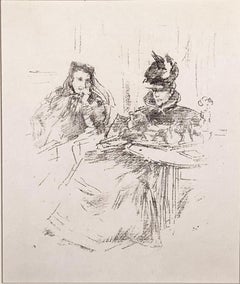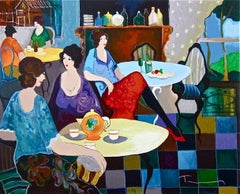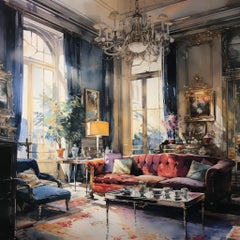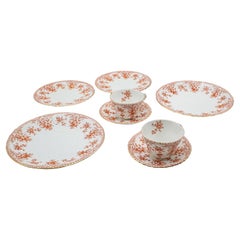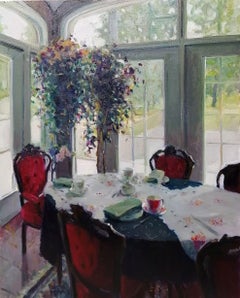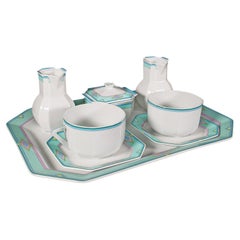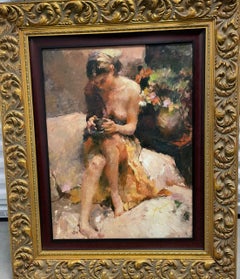Afternoon Tea
to
27
223
200
245
107
93
90
85
58
57
41
29
16
15
14
13
12
11
11
11
10
8
8
7
7
7
5
3
2
2
2
2
1
1
1
1
1
15
9
9
6
6
Sort By
AFTERNOON TEA
By James Abbott McNeill Whistler
Located in Portland, ME
Whistler, James A. M. AFTERNOON TEA. Way 147, Levy 114, TS&S 173. Lithograph, 1897. The only State
Category
1890s Figurative Prints
Materials
Lithograph
Afternoon Tea
By Itzchak Tarkay
Located in Fairfield, CT
Artist: Itzchak Tarkay (1935-2012)
Title: Afternoon Tea
Year: Circa 2000
Medium: Silkscreen on wove
Category
Early 2000s American Impressionist Figurative Prints
Materials
Screen
Antique Afternoon Tea Service, English, Pearline, Party, Davidson, Victorian
Located in Hele, Devon, GB
This is an antique afternoon tea service. An English, glass Pearline tea party set by Davidson
Category
Antique Late 19th Century British Victorian Tea Sets
Materials
Glass
$860
H 4.14 in W 5.71 in D 5.71 in
Afternoon Tea
Located in Brooklyn, NY
The watercolor artwork titled "Afternoon Tea" by Ashley Snyder transports viewers into a charming
Category
21st Century and Contemporary Contemporary Animal Paintings
Materials
Archival Ink, Rag Paper
Antique Afternoon Tea Set, English, Bone China, Cup & Saucer, Plate, Victorian
Located in Hele, Devon, GB
This is an antique two-person afternoon tea set. An English, bone China cup and saucer, sandwich
Category
Antique Late 18th Century British Victorian Tea Sets
Materials
Porcelain
$547
H 2.56 in W 5.52 in D 5.52 in
Afternoon Tea, Painting, Oil on Canvas
By Charles Choi
Located in Yardley, PA
One of my "Afternoon tea series", interior painting. :: Painting :: Realism :: This piece comes
Category
2010s Realist Paintings
Materials
Oil
Antique Afternoon Tea Service, English, Silver Plated, Serving Tray, Edwardian
Located in Hele, Devon, GB
This is an antique afternoon tea service. An English, silver plated 3 piece set with serving tray
Category
Early 20th Century British Edwardian Tea Sets
Materials
Silver Plate
$915
H 9.65 in W 14.97 in D 14.97 in
Vintage Afternoon Tea Set, French, Ceramic, Serving Tray, Cups, Art Deco Taste
Located in Hele, Devon, GB
This is a vintage cabaret afternoon tea set. A French, ceramic serving tray and tea cups in Art
Category
1990s French Art Deco Tea Sets
Materials
Ceramic
$1,154 / set
H 5.32 in W 15.75 in D 11.62 in
Afternoon Tea
By Hua Chen
Located in Chesterfield, MI
Hua Chen captured the ethereal beauty of this woman sitting down for an afternoon cup of tea.
This
Category
Late 20th Century Impressionist Nude Prints
Materials
Giclée
Afternoon Tea
By Donald S. Vogel
Located in Dallas, TX
Including the frame, the overall dimensions are 31 x 38 inches
Donald Vogel’s paintings reflect his interest in seeking beauty in life and in sharing pleasure with his viewers. Voge...
Category
1970s American Impressionist Figurative Paintings
Materials
Oil, Panel
Afternoon Tea Party, Impressionist Etching after Mary Cassatt
By Mary Cassatt
Located in Long Island City, NY
Mary Cassatt, After, American (1844 - 1926) - Afternoon Tea Party, Year: 1991; Original Published
Category
1990s Impressionist Figurative Prints
Materials
Etching
Antique Chinoiserie Serving Tray, Oriental, Japanned, Afternoon Tea, Victorian
Located in Hele, Devon, GB
This is a large antique Chinoiserie serving tray. An Oriental, Japanned afternoon tea platter
Category
Antique Late 19th Century Asian Platters and Serveware
Materials
Other
$1,342
H 1.19 in W 31.5 in D 24.81 in
Vintage Decorative Afternoon Tea Tray, English, Serving Platter, Regency Taste
Located in Hele, Devon, GB
This is a vintage decorative afternoon tea tray. An English, yew and mahogany inlaid serving
Category
Late 20th Century British Platters and Serveware
Materials
Wood
$881
H 2.17 in W 23.23 in D 14.38 in
Afternoon Tea by Charles-Joseph-Frédéric Soulacroix
Located in New Orleans, LA
Charles-Joseph-Frédéric Soulacroix
1825-1879 French
Afternoon Tea
Oil on canvas
Signed "F
Category
19th Century Figurative Paintings
Materials
Oil
$124,500
H 42 in W 33.75 in D 3.75 in
Antique Decorative Cake Stand, Sugar Bowl, English, Afternoon Tea, Victorian
Located in Hele, Devon, GB
This is an antique decorative cake stand and sugar bowl. An English, ceramic afternoon tea set
Category
Antique Late 19th Century British Late Victorian Ceramics
Materials
Ceramic
$744 / set
H 4.93 in W 9.26 in D 9.26 in
Vintage Presentation Serving Tray, English, Afternoon Tea, Aperitif Server, 1980
Located in Hele, Devon, GB
This is a vintage presentation serving tray. An English, mahogany afternoon tea or aperitif server
Category
Vintage 1980s British Regency Revival Serving Pieces
Materials
Mahogany
$855
H 1.78 in W 18.51 in D 12.6 in
Vintage Cake Stand, French, Cut Glass, Afternoon Tea Serving Platter, Circa 1950
Located in Hele, Devon, GB
This is a vintage cake stand. A French, glass afternoon tea serving platter, dating to the mid 20th
Category
Mid-20th Century French Platters and Serveware
Materials
Cut Glass
$1,017
H 5.12 in W 12.21 in D 12.21 in
Antique Decorative Afternoon Tea Tray, English, Serving Platter, Regency, C.1820
Located in Hele, Devon, GB
This is an antique decorative afternoon tea tray. An English, mahogany and boxwood serving platter
Category
Antique 1820s British Regency Platters and Serveware
Materials
Brass
$1,017
H 2.56 in W 22.84 in D 14.77 in
Antique Presentation Serving Tray, English, Silver Plated, Afternoon Tea, C.1895
Located in Hele, Devon, GB
This is an antique presentation serving tray. An English, silver plated afternoon tea platter
Category
Antique Late 19th Century British Serving Pieces
Materials
Silver Plate
$1,984
H 2.17 in W 28.35 in D 18.31 in
Antique Carved Serving Tray, Anglo-Indian, Teak Afternoon Tea Platter, Victorian
Located in Hele, Devon, GB
This is an antique carved serving tray. An Anglo-Indian, teak afternoon tea or cocktail platter
Category
Early 20th Century Indian Late Victorian Serving Pieces
Materials
Teak
$1,169
H 0.99 in W 18.51 in D 12.41 in
Joanne Heath-Menger, Afternoon Tea, Watercolor Painting, Canada, Circa 1980
Located in Chatham, ON
Joanne Heath-Menger- 'Afternoon Tea' - Vintage watercolor painting over graphite on paper - signed
Category
Late 20th Century Canadian Romantic Paintings
Materials
Glass, Softwood, Lacquer, Paint, Paper
$375
H 15 in W 16.25 in D 0.75 in
Vintage Set of 12 Cake Forks, English, Silver, Afternoon Tea, Cutlery, Art Deco
Located in Hele, Devon, GB
This is a vintage set of 12 cake forks. An English, silver case of afternoon tea cutlery
Category
Mid-20th Century British Sheffield and Silverplate
Materials
Silver
$874
H 0.99 in W 10.24 in D 7.49 in
Original Antique Advertising Poster Maximilian Cafe Restaurant Afternoon Tea Art
Located in London, GB
Original antique poster advertising elegant afternoon tea at the Maximilian cafe restaurant with a
Category
Vintage 1920s German Art Deco Posters
Materials
Paper
$6,147
H 47.25 in W 33.47 in D 0.04 in
Large Antique Presentation Tray, Egyptian Silver Plate, Afternoon Tea, Victorian
Located in Hele, Devon, GB
This is a large antique presentation tray. An Egyptian, silver plated afternoon tea serving
Category
Antique Late 19th Century Egyptian Late Victorian Sheffield and Silverplate
Materials
Silver Plate
$1,640
H 1.58 in W 27.56 in D 16.15 in
Vintage Cake Stand, English, Ceramic, Afternoon Tea Fancies Dish, Circa 1970
Located in Hele, Devon, GB
This is a vintage cake stand. An English, ceramic afternoon tea fancies dish, dating to the late
Category
Late 20th Century British Mid-Century Modern Ceramics
Materials
Ceramic
$1,012
H 4.34 in Dm 9.06 in
Antique Tipple Serving Tray, English, Oak, Boxwood, Afternoon Tea, Edwardian
Located in Hele, Devon, GB
This is an antique tipple serving tray. An English, oak and boxwood inlaid afternoon tea platter
Category
Early 20th Century British Edwardian Serving Pieces
Materials
Boxwood, Oak
$1,012
H 2.17 in W 22.05 in D 14.38 in
Vintage Oval Serving Tray, English Silver Plate, Afternoon Tea, Decorative, 1950
Located in Hele, Devon, GB
This is a vintage oval serving tray. An English, silver plated afternoon tea platter, dating to the
Category
Mid-20th Century British Platters and Serveware
Materials
Silver Plate
$607
H 1.58 in W 21.66 in D 16.15 in
Antique Folding Silver Table, Chinese, Serving Tray, Afternoon Tea, Victorian
Located in Hele, Devon, GB
colour and fascinating carved details throughout. Perfect as a coffee table or used as an afternoon tea
Category
Antique Mid-19th Century Chinese Tray Tables
Materials
Wood
$5,368
H 23.82 in W 28.94 in D 20.67 in
Antique Cake Stand, English, Silver Plate Serving Dish, Afternoon Tea, Victorian
Located in Hele, Devon, GB
for afternoon tea.
Dimensions:
Max width: 31cm (12.25'')
Max depth: 31cm (12.25'')
Max height
Category
Antique Late 19th Century British Platters and Serveware
Materials
Silver Plate
$1,379
H 8.08 in W 12.21 in D 12.21 in
Antique Oval Decorative Serving Tray, English, Silver Plate, Afternoon Tea, 1910
Located in Hele, Devon, GB
This is an antique oval decorative serving tray. An English, silver plate afternoon tea plater by
Category
Early 20th Century British Platters and Serveware
Materials
Silver Plate
$1,400
H 1.58 in W 27.76 in D 17.33 in
"Afternoon Tea" (2024) By Danny McCaw, Original Abstract Portrait Oil Painting
By Danny McCaw
Located in Denver, CO
Danny McCaw's (US based) "Afternoon Tea" is an original, handmade oil painting with impasto
Category
2010s Abstract Impressionist Abstract Paintings
Materials
Oil, Board
Antique Two Tier Dumb Waiter, English, Afternoon Tea, Jardiniere Stand, Georgian
Located in Hele, Devon, GB
refined craftsmanship and a tasteful appearance — ideal for afternoon tea service or as a decorative plant
Category
Antique 1790s British Georgian Pedestals and Columns
Materials
Mahogany
$5,044 / item
H 38.78 in W 24.02 in D 24.02 in
White Edwardian Net Rosebud Afternoon Tea or Bridal Gown - XXS, Early 1900s
Located in Tucson, AZ
It’s easy to see why tea dresses such as this were sometimes called “pneumonia dresses”: their
Category
Early 20th Century Unknown Tea Gowns
$550
Size: none; comparable to size XXS
Afternoon Tea, Original Signed Impressionist Still Life Painting on Canvas
Located in Boston, MA
Afternoon Tea, Original Contemporary Impressionist Floral Still Life Painting, 2016
30" x 24" x 1.5
Category
21st Century and Contemporary Impressionist Still-life Paintings
Materials
Canvas, Acrylic
$1,800
H 30 in W 24 in D 1.5 in
Afternoon Tea - original still life painting - contemporary art
By Keimpe van der Kooi
Located in London, Chelsea
This exceptional artwork is currently on display and available for sale at Signet Contemporary Art Gallery and online.
A feast for the senses, Abundance by Keimpe van der Kooi is an...
Category
21st Century and Contemporary Impressionist Still-life Paintings
Materials
Oil, Canvas, Acrylic
$3,824
H 39.38 in W 31.5 in
A. Chambers - Framed Early 20th Century Watercolour, Afternoon Tea
Located in Corsham, GB
, an elderly man is pictured enjoying a generous cup of tea and a slice of cake in an all frills dining
Category
Early 20th Century Interior Drawings and Watercolors
Materials
Watercolor
$260 Sale Price
20% Off
H 13.98 in W 17.92 in
THE GARDEN TABLE AFTERNOON TEA YURI KROTOV contemporary Russian artist
By Yuri Krotov
Located in Pollenca, Illes Baleares
Yuri Krotov was born 1964 in Grivenskaya Cossack Settlement, Krasnodar Territory, located close to the Azov Sea. At the age of 8 he met a local painter G.A. Polugaev who became his ...
Category
21st Century and Contemporary Impressionist Landscape Paintings
Materials
Oil
$3,073
H 19.3 in W 24.02 in D 13.39 in
Afternoon tea , 1912 Oil on canvas Auguste Moreau-Deschanvres (1838-1913)
Located in Gent, VOV
Auguste Moreau-Deschanvres (1838-1913)
A student of Julien Potier at the Valenciennes academic schools, the painter Auguste Moreau-Deschanvres (1838-1913) lived in the house-studio h...
Category
20th Century Figurative Paintings
Materials
Canvas, Oil
$15,555
H 20.87 in W 25.6 in
Low Antique Lamp Table, English, Afternoon Tea, Side, Wine, Victorian Circa 1890
Located in Hele, Devon, GB
This is a low antique lamp table. An English, mahogany and beech side or tea table, dating to the
Category
Antique 1890s British Late Victorian Side Tables
Materials
Beech, Mahogany
$1,876
H 14.38 in W 20.87 in D 20.87 in
Victorian Ornate Three Tier Muffin Stand with Plate Holders for Afternoon Tea
Located in Miami Beach, FL
The ornate muffin stand has splay feet and 3 tiers made to hold 3 cake or muffin plates. The base and top of the handle have ornate curlicues while the plate holder sections are intr...
Category
Antique Late 19th Century American Victorian Serving Tables
Materials
Wicker
$1,250
H 42 in W 12.5 in D 12.5 in
Vintage 10 Person Tea Set, English, Ceramic, Afternoon Service, Waring & Gillow
Located in Hele, Devon, GB
This is a vintage 10 person tea set. An English, ceramic afternoon tea service, dating to the early
Category
Mid-20th Century British Tea Sets
Materials
Ceramic
$1,640
H 2.17 in W 5.52 in D 5.52 in
Vintage Boho Floral Carlton Ware Tea Set of 21
By Carlton Ware Ltd
Located in West Palm Beach, FL
. Perfect for afternoon tea or display, this set brings a lively, artistic touch to any setting. Crafted
Category
Mid-20th Century American Mid-Century Modern Tea Sets
Materials
Ceramic
Art Deco Sterling Silver Tea & Coffee Set
By Walker & Hall
Located in London, GB
A rare and unusual sterling silver tea and coffee set of art deco design. The four pieces were
Category
Vintage 1930s English Art Deco Tea Sets
Materials
Silver
1750s Swedish Rococo Gray Painted Tea Table with Tray Top and Ball and Claw Feet
Located in Atlanta, GA
stage for your most cherished keepsakes or afternoon tea rituals.
Descending from the apron, the table
Category
Antique Mid-18th Century Swedish Rococo Card Tables and Tea Tables
Materials
Wood
$5,450
H 28.5 in W 34.75 in D 26.5 in
Tea Set Antique Krautheim Selb Bavaria Art Deco Ivory Bone China
Located in Bastogne, BE
ready to grace your table. Perfect for afternoon tea, special occasions, or simply adding a touch of
Category
Vintage 1920s German Art Deco Tea Sets
Materials
Porcelain
Antique Chinese Porcelain Tea Set, 3 Person, Early 20th C., Hand-Painted
Located in Bastogne, BE
and care taken in its creation.
Imagine enjoying a quiet afternoon tea, steeped in history and
Category
Vintage 1910s Chinese Chinoiserie Tea Sets
Materials
Porcelain
Vintage 6 Person Tea Service, English, Ceramic, Decorative, Teapot, Serving Jug
Located in Hele, Devon, GB
This is a vintage 6 person tea service. An English, ceramic decorative afternoon tea set with
Category
Mid-20th Century British Tea Sets
Materials
Ceramic
$1,575
H 6.5 in W 5.52 in D 8.86 in
19th Century English Edwardian Handkerchief Game Table
Located in Atlanta, GA
design, where the square top unfolds into a larger gaming surface, perfect for card games or afternoon
Category
Antique 19th Century English Card Tables and Tea Tables
Materials
Mahogany
Antique Tea Service, English, Silver Plate, Hand Chased, Teapot, Jug, C.1900
Located in Hele, Devon, GB
Victorian afternoon tea service
Displaying a desirable aged patina with minimal tarnish
Silver plate shows
Category
Antique Late 19th Century British Tea Sets
Materials
Silver Plate
$846
H 8.67 in W 5.52 in D 9.85 in
1980s Vintage Arcoroc Black Glass Domed Cake Plate and Five Cups and Saucers
By Arcoroc
Located in San Gabriel, CA
cake platter and dome set make for a wonderful afternoon tea presentation.
The measurements listed are
Category
Vintage 1980s European Post-Modern Tea Sets
Materials
Glass
$185
H 5 in W 12 in D 12 in
Vintage Villeroy & Boch Gallo Design Bone China Tea Set, Floral 1970s, 23 Pc
By Villeroy & Boch
Located in Bastogne, BE
, creating a warm and inviting atmosphere for afternoon tea or special gatherings.
Tea Service includes
Category
Vintage 1970s German Tea Sets
Materials
Porcelain
$894 / set
H 11.82 in Dm 5.91 in
Coffee Set Vintage Tuscan England Bone China Pale Pink Enamel Gold Plate 1960s
Located in Bastogne, BE
effortlessly complements any setting, from a formal afternoon tea to a cozy morning coffee.
This set is more
Category
Vintage 1960s British Tea Sets
Materials
Bone
$207 / set
H 1.58 in Dm 4.53 in
Antique Tea Set 3 Part English Silver, Serving Tray, Home Decorative Objects
Located in Wembley, GB
An antique afternoon tea set. An English Sheffield, silver 3-pieces set with a serving tray, dating
Category
Antique 1830s English Art Deco Sterling Silver
Materials
Gold Plate, Silver, Sterling Silver
$284 Sale Price
56% Off
H 5.12 in W 9.85 in D 1.19 in
20-Piece Tea Service Jacobean Pattern By W. H. Grindley & Co.
By W. H. Grindley & Co.
Located in Worcester Park, GB
joyfully used — perfect for slow mornings or afternoon tea with guests.
W.H. Grindley & Co. was founded in
Category
Mid-20th Century English Country Tea Sets
Materials
Earthenware
Vintage Alberto Pinto for Raynaud Limoges “Christobal” Service for 6 - 18 Pieces
By Limoges
Located in West Palm Beach, FL
course or afternoon tea. This designer vintage set is a true testament to refined taste and versatile
Category
Late 20th Century French Tea Sets
Materials
Porcelain
$1,650 / set
H 0.75 in W 7.5 in D 7.5 in
Antique Whatnot Stand, Two-Tier Dumb Waiter, Tea Table, Victorian, 1900
Located in Hele, Devon, GB
This is an antique whatnot stand. An English, mahogany two-tier afternoon tea table, dating to the
Category
Antique Late 19th Century English Victorian Serving Tables
Materials
Mahogany
$1,495
H 32.68 in W 17.33 in D 15.95 in
Antique Silver Plated Empire Revival Tea Caddy 19th Century
Located in London, GB
an elegant touch to your next afternoon tea with this delightful caddy.
Condition:
In excellent
Category
Antique 1860s Empire Revival Sheffield and Silverplate
Materials
Silver Plate
Set Of 6 Liberty & Co Cake Forks with 6 Teaspoons To Match, 1928/1933, Birmingham
By Liberty & Co.
Located in London, GB
decent gauge of silver, perfect for serving afternoon tea!
Category
Vintage 1930s English Arts and Crafts Sterling Silver
Materials
Sterling Silver
$1,024
H 5 in W 0.5 in D 0.5 in
- 1
Get Updated with New Arrivals
Save "Afternoon Tea", and we’ll notify you when there are new listings in this category.
Afternoon Tea For Sale on 1stDibs
You are likely to find exactly the afternoon tea you’re looking for on 1stDibs, as there is a broad range for sale. You can easily find an example made in the Contemporary style, while we also have 5 Contemporary versions to choose from as well. If you’re looking for an afternoon tea from a specific time period, our collection is diverse and broad-ranging, and you’ll find at least one that dates back to the 19th Century while another version may have been produced as recently as the 21st Century. If you’re looking to add an afternoon tea to create new energy in an otherwise neutral space in your home, you can find a work on 1stDibs that features elements of brown, beige, black, gray and more. Creating an afternoon tea has been a part of the legacy of many artists, but those crafted by Itzchak Tarkay, James Abbott McNeill Whistler, Marcel Brunery, (after) Mary Cassatt and Charles Edward Chambers are consistently popular. These artworks were handmade with extraordinary care, with artists most often working in paint, oil paint and canvas.
How Much is a Afternoon Tea?
The average selling price for an afternoon tea we offer is $3,100, while they’re typically $475 on the low end and $150,000 for the highest priced.
More Ways To Browse
Wrought Iron Dining Sets With Marble Or Granite Top
All Meissen Blue Onion Centerpiece Or Fruit Bowl
Edwardian Or 1910s Dresses
Foldable Side Table Or Serving Tray
19501960 Glass Sugar Shaker Or Pourer
Andor Chair
Antique Craft Table
English Antique Glass
Antique Paint Set
Retro Kitchen Sets
Silver Match
Side Table With Lamp
English Oak
26 X 26 Table
Blue And Gold Plates
Conservatory Furniture Used
Used Serving Trays
Naturalistic Furniture
